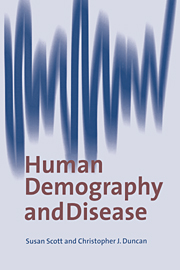Book contents
- Frontmatter
- Contents
- Preface
- Conversion table for imperial to metric units
- 1 Introduction
- 2 Tools for demography and epidemiology
- 3 Identification of population oscillations: a case study
- 4 Density-dependent control and feedback
- 5 Modelling the endogenous oscillations and predictions from timeseries analysis
- 6 Cycles in the grain price series
- 7 Interactions of exogenous cycles: a case study
- 8 Mortality crises and the effects of the price of wool
- 9 Modelling epidemics for the demographer: the dynamics of smallpox in London
- 10 Non-linear modelling of the 2-yearly epidemics of smallpox: the genesis of chaos?
- 11 Measles and whooping cough in London
- 12 Integration of the dynamics of infectious diseases with the demography of London
- 13 Smallpox in rural towns in England in the 17th and 18th centuries
- 14 Infectious diseases in England and Wales in the 19th century
- 15 Prospectives – towards a metapopulation study
- References
- Index
8 - Mortality crises and the effects of the price of wool
Published online by Cambridge University Press: 25 January 2010
- Frontmatter
- Contents
- Preface
- Conversion table for imperial to metric units
- 1 Introduction
- 2 Tools for demography and epidemiology
- 3 Identification of population oscillations: a case study
- 4 Density-dependent control and feedback
- 5 Modelling the endogenous oscillations and predictions from timeseries analysis
- 6 Cycles in the grain price series
- 7 Interactions of exogenous cycles: a case study
- 8 Mortality crises and the effects of the price of wool
- 9 Modelling epidemics for the demographer: the dynamics of smallpox in London
- 10 Non-linear modelling of the 2-yearly epidemics of smallpox: the genesis of chaos?
- 11 Measles and whooping cough in London
- 12 Integration of the dynamics of infectious diseases with the demography of London
- 13 Smallpox in rural towns in England in the 17th and 18th centuries
- 14 Infectious diseases in England and Wales in the 19th century
- 15 Prospectives – towards a metapopulation study
- References
- Index
Summary
Mortality crises in northwestern England
In addition to visitations of the plague, Cumberland and Westmorland suffered three major mortality crises at the end of the 16th century and the start of the 17th century, in 1587/8, 1596/7 and 1623. Events during the 1623 crisis at Penrith have been described in the preceding chapter. The recurring population crises in England between 1550 and 1640 have long been known to historians, and influenza, typhus and plague have been blamed for the excess deaths. Appleby (1973) has made a careful study of a series of parishes in the northwest and has addressed the problem of whether these crises were the results of disease or starvation. He makes the following point ‘we must be able to separate starvation from disease. Confounding the two confuses their causes which can be quite different. A community troubled by recurring famine is either poor or has a grossly inequitable distribution of wealth. A community afflicted with epidemic disease is not necessarily either of these.’ He concludes from his study that the crisis of 1587/8 was probably caused by typhus augmented by famine, whereas the mortality in Cumbria in 1596/7 was caused by starvation and not by epidemic disease. The disastrous harvest of 1596 would have led to the excessive mortality in 1597, allowing a short lag as the poor took the desperate measure of selling their few possessions to avert starvation. Famine was again widespread in 1623 and he concludes that it was entirely responsible for the excessive mortality in that year.
- Type
- Chapter
- Information
- Human Demography and Disease , pp. 145 - 168Publisher: Cambridge University PressPrint publication year: 1998



